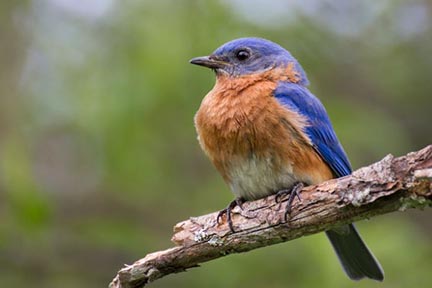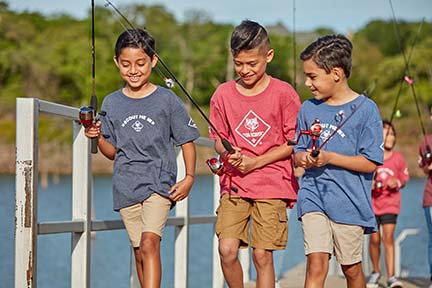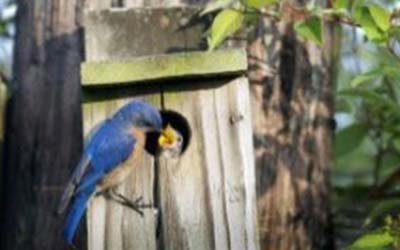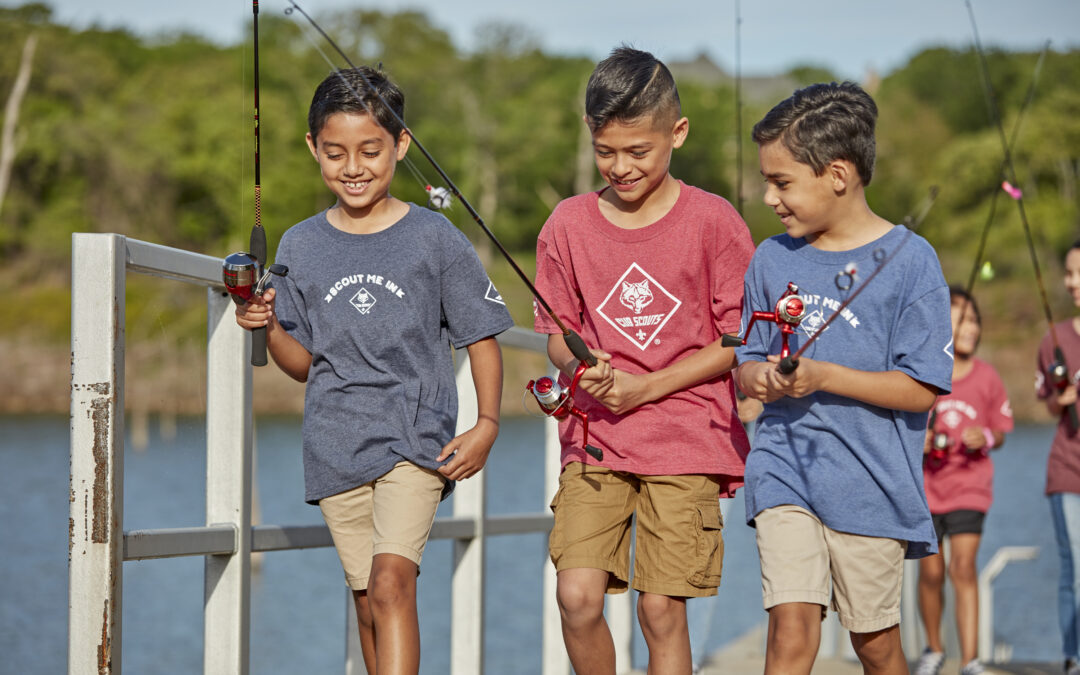| Here are a few stories from the Michigan Department of Natural Resources ahead of the busy Memorial Day holiday weekend. Have fun, stay safe and take care of the outdoors!
See other news releases, Showcasing the DNR stories, photos and other resources at Michigan.gov/DNRPressRoom.
PHOTOS: Larger, high-resolution versions of some of the images used in this email (marshmallows, trails, beach, ORVs, campfire and purple loosestrife) are available in the DNR’s public image gallery. The National Safe Boating Council provided the photo of the woman in a life jacket on a boat. It and several others are available on this NSBC photo library page.
 If you’re heading up north for the first time since the massive ice storm struck in late March, be ready – the unprecedented damage in some areas may be shocking. And you’ll need to be extra careful when heading into the woods because of broken branches both overhead and underfoot. If you’re heading up north for the first time since the massive ice storm struck in late March, be ready – the unprecedented damage in some areas may be shocking. And you’ll need to be extra careful when heading into the woods because of broken branches both overhead and underfoot.
All state park campgrounds and overnight lodging locations in affected parks have reopened. Please keep in mind that in some areas the landscape may look different and some day-use areas, such as boating access sites and park trails, may still be closed.
If you plan to hit a trail or a forest road, look ahead as usual – but also look up and down. Some broken limbs and branches are still hanging in some trees and may fall without warning. In other cases, trees are down or leaning on other trees. For your safety, please respect all closures. If there are open trails in the park or region, please stay on the trail corridor due to potential hazards in the surrounding forest.
The storms profoundly affected nearly 1 million acres of state forest land, including 3,400 miles of state forest roads, 19 state parks, 54 state forest campgrounds, 169 boating access sites and 3,260 miles of trails (including 1,700 miles of state-designated ORV trails and routes).
“Crews have been working hard to reopen forest roads and trails and repair state facilities, and they’ve made a lot of progress so far,” said Kerry Heckman, public information officer for the DNR Ice Storm Response Team. “We know everyone wants to get outside to enjoy Michigan’s great outdoors, and we want that, too. But it’s critical to use caution, steer clear of closed areas and be fully aware of your surroundings.”
Find a dedicated map and dashboard with the latest status (open, partially open, closed) of state parks, state-managed trails, boating access sites and state forest campgrounds, safety updates and more at the DNR’s Ice Storm Response page.
Questions? Contact Beth Fults at FultsB@Michigan.gov. |
 Summer’s here, and the waters beckon! For the added safety of residents and visitors, many Michigan state parks offer buoyed swim areas and the Great Lakes flag warning system Memorial Day through Labor Day. DNR staff inspect these buoyed swim areas roughly every two weeks to ensure shallower water (under 5 feet at installation) and identify potential hazards. Summer’s here, and the waters beckon! For the added safety of residents and visitors, many Michigan state parks offer buoyed swim areas and the Great Lakes flag warning system Memorial Day through Labor Day. DNR staff inspect these buoyed swim areas roughly every two weeks to ensure shallower water (under 5 feet at installation) and identify potential hazards.
However, installation of swim buoys is delayed at several locations due to this year’s cooler temperatures in the Great Lakes and inland lakes. Those chillier temps are creating conditions that make it dangerous for DNR staff to complete the installation. Not all buoys will be in place until weather conditions allow for safe installation.
“We want to remind our visitors to be cautious of cold-water temperatures. Sudden immersion and/or sustained time in cold water can cause cold shock, making it hard to breathe and increasing your risk of drowning,” said Pat Whalen, Plainwell District supervisor for the DNR Parks and Recreation Division.
To keep everyone safe, follow these must-know tips throughout the swim season:
- Check beach flags in buoyed swim areas (double-red flags = water access closed, red flag = high hazard, yellow flag = medium hazard, green flag = low hazard). By law, you cannot enter the water from the beach when double-red flags are flying or if otherwise directed.
- The absence of flags does not ensure safe swimming conditions. Swim at your own risk and be vigilant about monitoring beach and water conditions.
- For safer swimming, choose buoyed swim areas when visiting many state parks. These areas offer added safety measures and visual cues, helping you avoid potentially hazardous locations like piers with structural currents. Keep in mind that not all state parks offer buoyed swim areas.
- Never swim alone, especially children.
- Keep close watch on children and less experienced swimmers: Stay within arm’s reach, have them wear U.S. Coast Guard-approved life jackets, be conscious of their limits and take frequent breaks.
- Be aware of water temperatures and weather warnings.
- Water currents near piers, breakwalls and outlets of rivers can be extremely hazardous.
|
When enjoying any of Michigan’s waters, especially the Great Lakes, remember their immense size and power. Holding over one-fifth of the world’s fresh water, the Great Lakes can have strong currents that can unexpectedly challenge the strongest of swimmers.
For beach safety information – including buoyed swim area locations, the Great Lakes flag warning system meanings, and current awareness and escape strategies – visit Michigan.gov/BeachSafety.
Questions? Contact Pat Whalen, Plainwell District supervisor for the DNR Parks and Recreation Division, 269-838-1196.
 Many Michiganders and visitors will unofficially launch the boating season this holiday weekend. Whether you’re a boater, angler or other water sports enthusiast, safety and common sense in and around the water are a must. Many Michiganders and visitors will unofficially launch the boating season this holiday weekend. Whether you’re a boater, angler or other water sports enthusiast, safety and common sense in and around the water are a must.
The DNR is proud to promote National Safe Boating Week, May 17-23, and safe boating practices all year long. Where the cause of death was known, U.S. Coast Guard statistics show that drowning was the reported cause in 75 percent of recreational boating fatalities in 2023, and that 87 percent of those who drowned were not wearing life jackets.
Before leaving shore, consider these boating safety tips: |
- Wear a U.S. Coast Guard-approved life jacket. Situations on the water can happen much too fast to reach and put on a stowed life jacket.
- Always ride with an operator who has completed an approved boater safety course. In Michigan, boater safety certificates are needed by anyone born after June 30, 1996, operating a motorized boat, or anyone born after Dec. 31, 1978, operating a personal watercraft – like a Jet Ski. Most states require a boater safety certificate for boat or personal watercraft rentals.
- Make sure your boat is in good working condition and prepared with the necessary equipment.
- File a float plan with someone you trust. Include details about the trip, boat, others on board, towing or trailer vehicle, communication equipment and emergency contacts.
- Check the weather, including the water temperature, and monitor changing conditions.
- Boat sober. Where the primary cause was known, alcohol was listed as a leading factor in boating-related deaths.
- Beware of carbon monoxide poisoning. Gasoline-powered engines on boats, including onboard generators, produce carbon monoxide, a colorless and odorless gas that can poison or kill someone who breathes too much of it. Install and maintain a working CO detector, never block exhaust outlets, and always dock, beach or anchor at least 20 feet away from any boat running a generator or engine.
- Keep in touch. Communication devices, such as marine radios, can be your most important piece of emergency equipment.
Visit Michigan.gov/RecreationalSafety for information on earning your boating, hunting, snowmobile or off-road vehicle safety certificate.
Questions? Email Cpl. Jill Miller at MillerJ86@Michigan.gov.
 Off-road vehicles are fun year-round, but activity in Michigan ramps up in spring and summer as people head to trails and ORV scramble areas to enjoy world-class riding experiences. Off-road vehicles are fun year-round, but activity in Michigan ramps up in spring and summer as people head to trails and ORV scramble areas to enjoy world-class riding experiences.
Keeping safety in mind is vital on any ride, for you and others. According to 2023 statewide ORV crash data, 93% of ORV fatalities could have been prevented. These crashes were primarily due to excessive speed and a lack of helmet/seat belt use.
“Always ride within your and the machine’s capabilities,” said Cpl. Mike Hearn, DNR law enforcement ORV and snowmobile specialist. “When operators ride too fast, they are more likely to lose control when they hit even the smallest bump or try to make turns or stop.”
All ORV operators are urged to “Ride Right” and keep this other important guidance in mind, too:
- Ride at a safe speed.
- Ride sober.
- Ride on the right side of the trail.
- Keep lights on when riding.
- Always wear a helmet.
Do your part to ensure everyone returns home safely; read more about ORV safety at Michigan.gov/RideRight. For more on state ORV laws and where to ride, visit Michigan.gov/ORVInfo.
Questions? Email Cpl. Mike Hearn at HearnM@Michigan.gov. |
 Many Michiganders’ favorite summer things involve fire, sparks and heat. Campfires, fireworks and a spin in an off-road vehicle: We love these as much as anyone, but safety has to come first. Many Michiganders’ favorite summer things involve fire, sparks and heat. Campfires, fireworks and a spin in an off-road vehicle: We love these as much as anyone, but safety has to come first.
People are responsible for starting nine out of 10 wildfires – almost never on purpose – and nearly all of these could have been prevented.
Next time you plan to burn, keep these safety tips in mind:
- Build your campfire in a metal ring or pit. Never leave a fire unattended, even for a moment. When you’re done, thoroughly douse the fire with water, stir and douse again.
- When using fireworks, keep a hose handy and make sure to soak used sparklers in water before discarding them. Never shoot fireworks into dry grass, brush or trees.
- When barbecuing, never leave the grill unattended and keep a water source nearby.
- Taking a trailer up north? Ensure tow chains don’t drag and cause sparks, which can light a fire along the road’s edge.
- Avoid using heavy machinery like lawnmowers in dry areas. Don’t park an ORV or other vehicle on dry grass, as a hot exhaust system can ignite the grass.
- Before burning yard debris, see if burn permits are being issued or if weather conditions allow for safe burning. Check the burn permit page or call 866-922-BURN (866-922-2876) for more information. People in Michigan’s 12-county ice storm emergency area are asked to hold off on burning and to take fallen limbs and other debris to dropoff sites.
- If you do burn, keep your debris piles small. A large pile can burn for hours.
Learn more at Michigan.gov/FireSafety. Questions? Contact DNR fire prevention specialist Paul Rogers at 616-260-8406. |
 Wherever summer plans take you, do your part to make sure that invasive plants (like purple loosestrife, shown here), animals and pests don’t go along for the ride. A number of invasive species currently threaten Michigan’s woods and water, but there are some easy ways everyone can help to stop their spread. Wherever summer plans take you, do your part to make sure that invasive plants (like purple loosestrife, shown here), animals and pests don’t go along for the ride. A number of invasive species currently threaten Michigan’s woods and water, but there are some easy ways everyone can help to stop their spread.
Sometimes it’s just about knowing how to take action. Fortunately, Michigan’s Invasive Species Program has excellent, clear-cut guidance for boaters and anglers, campers, hunters and trail users, and land owners, gardeners and pond owners.
Before ever leaving the house, though, it’s good to know exactly what you’re looking for and what do do when you find it! Check out the invasive species identify and report page for profiles on different species and guidance on how best to report them. Invasive species of greatest concern in Michigan are on the Watch List, and several species are prohibited or restricted in Michigan.
Questions? Contact Joanne Foreman, DNR invasives species communications coordinator, at 517-243-6450. |
|










